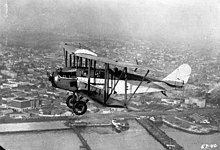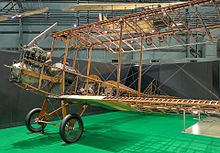| This article has an unclear citation style. The references used may be made clearer with a different or consistent style of citation and footnoting. (April 2013) (Learn how and when to remove this message) |
| Standard J | |
|---|---|

| |
| Role | TrainerType of aircraft |
| National origin | United States |
| Manufacturer | Standard Aircraft Corporation |
| Designer | Charles Healy Day |
| First flight | 1916 |
| Number built | 1,600+ |
| Developed from | Sloan H series |
The Standard J is a two-seat basic trainer two-bay biplane produced in the United States from 1916 to 1918, powered by a four-cylinder inline Hall-Scott A-7a engine. It was constructed from wood with wire bracing and fabric covering. The J-1 was built as a stopgap to supplement the Curtiss JN-4 in production.
Development
Charles Healy Day had designed the preceding Sloan H series of aircraft, and continued the line under the Standard Aero Corporation (later Standard Aircraft Corporation). Four companies, Standard, Dayton-Wright, Fisher Body, and Wright-Martin, delivered 1,601 J-1s between June 1917 and June 1918. The Standard J-1 can be differentiated from the Curtiss JN series by its slightly swept-back wing planform, triangular king posts above the upper wings, and the front legs of the landing gear which were mounted behind the lower wing's leading edge, just about where the forward wing spar of the lower wing panel attaches to the fuselage.
Operational history

Although produced in large numbers, its four-cylinder Hall-Scott A-7a engine was unreliable and vibrated badly. While JN-4 production outnumbered J-1s by about two to one in June 1918, fatalities in JN-4s versus J-1s numbered about seven to one due to the limited use of the J-1s. Few later production J-1s left their delivery crates.
In June 1918, all Standard J-1s were grounded, although training remained intensive. Sufficient JN-4s were available to meet training needs, and at $2,000 per aircraft it was not cost-effective to convert them to use Curtiss OX-5 engines. Contracts for 2,600+ JS-1s were canceled, and those not used for ground instruction by the US Army were sold as surplus or scrapped. Curtiss, which produced its competitor (the Curtiss JN) bought surplus J-1s which they modified with different powerplants, for resale.
Many J-1s were flown by civilian flying schools, and for joy-riding and barnstorming operations, until they were worn out, or were forced into retirement by new air transport legislation in 1927 which banned passenger aircraft with wood structures due to a number of high-profile accidents.
Variants

- Sloan H series: trainers and reconnaissance aircraft from 1913
- Standard H series: production by Standard of Sloan H-series
- Standard J: first Standard-designed variant
- Standard J-1: trainer for U.S. Army
- Standard SJ-1: J-1 with additional pair of forward wheels to prevent noseovers
- Standard JR-1: advanced trainer for US Army
- Standard JR-1B: mail carrier for US Post Office, modification of JR-1
- Standard E-4: redesignated JR-1B mailcarrier
War-surplus conversions

- Aerial Engineering Corporation Standard 6W-3: Modification for a pilot and four passengers. Also known as the Mercury Standard 6
- Curtiss Night Mail: 1922 mailplane conversion of J-1 by Curtiss with new wings (about 6 converted)
- Lincoln Standard L.S.5: J-1 modified with an open cockpit for four passengers
- Nicholas-Beazley-Standard: J-1 aircraft modified by Nicholas-Beazley
- Ryan Standard: J-1 with a 180 hp Hispano Suiza engine and an enclosed cabin for four passengers fitted by the Ryan Flying Company (9 converted)
- Sikorsky Standard: civil trainer with Sikorsky-Gluhareff Parasol wing (also known as Standard SJ)
Operators
- United States Army Air Service
- United States Navy
- United States Post Office Department
- The San Diego—Los Angeles Airlines
Surviving aircraft


Over a dozen J-1s are on display or being restored. Others projects are incomplete and awaiting restoration.
- 214 – J-1 on static display at the Yanks Air Museum in Chino, California.
- 581 – J-1 airworthy at the Owls Head Transportation Museum in Owls Head, Maine. It has a Hispano-Suiza V-8 engine installed.
- 1000 – J-1 airworthy with James F. Hammond of Yellow Springs, Ohio.
- 1141 – J-1 on static display at the National Museum of the United States Air Force in Dayton, Ohio. It is displayed without a right wing or fabric covering, has a Hall-Scott A-4A engine installed, and was donated by Robert Greiger in December 1962.
- 1582 – J-1 in storage at the Fantasy of Flight in Polk City, Florida. It is composite of two airframes.
- 1598 – J-1 on static display at the San Diego Aerospace Museum in San Diego, California.
- 1956 – J-1 airworthy at the EAA Aviation Museum in Oshkosh, Wisconsin. It has a Hispano-Suiza Model A engine installed.
- 2434 – J-1 on display at the Fargo Air Museum in Fargo, North Dakota. It is on loan from Bonanzaville, U.S.A. It has an OXX-6 engine installed.
- 2969 – J-1 airworthy with Walter C. Bowe of Sonoma, California. It is assembled from original components as a period kit.
- 41236 – J-1 on static display at the Glenn H. Curtiss Museum in Hammondsport, New York. It is on loan from the Henry Ford Museum.
- T-4595 – J-1 at the Historic Aircraft Restoration Museum in Creve Coeur, Missouri.
- T-4598 – J-1 airworthy with the Freeman Heritage Collection in Kingsbury, Texas.
- T-4732 – J-1 airworthy with C C Air Corp of Port Hueneme, California.
- J-1 on static display at the National Museum of the United States Air Force in Dayton, Ohio. It has an OXX-6 engine installed.
Specifications (SJ)

Data from The Standard Aero Corporation Model J Training Tractor
General characteristics
- Crew: 2
- Length: 26 ft 7 in (8.10 m)
- Upper wingspan: 43 ft 11 in (13.39 m)
- Lower wingspan: 32 ft (9.8 m)
- Height: 10 ft 10 in (3.30 m)
- Wing area: 429 sq ft (39.9 m)
- Airfoil: R.A.F No 3
- Empty weight: 1,350 lb (612 kg)
- Gross weight: 1,950 lb (885 kg)
- Fuel capacity: 31 US gal (26 imp gal; 120 L)
- Powerplant: 1 × Hall-Scott A-7 water-cooled straight-4 engine, 100 hp (75 kW)
Performance
- Maximum speed: 68 mph (109 km/h, 59 kn)
- Stall speed: 37 mph (60 km/h, 32 kn)
- Range: 350 mi (560 km, 300 nmi)
- Time to altitude: 10 minutes to 2,600 ft (790 m)
See also
Aircraft of comparable role, configuration, and era
Related lists
References
- Notes
- ^ Radecki, Alan (2012). "The First Airline in America". Vintage Air. Retrieved 12 November 2015.
- "Les Ailes : journal hebdomadaire de la locomotion aérienne / directeur, rédacteur en chef, Georges Houard". Gallica. 1926-02-18. Retrieved 2018-08-17.
- The Illustrated Encyclopedia of Aircraft p.2835
- Taylor 1989, p.774
- "Standard J-1". Yanks Air Museum. Yanks Air Museum. 2017-02-06. Retrieved 10 May 2017.
- "Airframe Dossier — StandardH / J / SJ / JR / E-4, c/n 214, c/r N214J". Aerial Visuals. AerialVisuals.ca. Retrieved 10 May 2017.
- "1918 STANDARD J-1". Owls Head Transportation Museum. Owls Head Transportation Museum. Retrieved 10 May 2017.
- "FAA REGISTRY [N22581]". Federal Aviation Administration. U.S. Department of Transportation. Retrieved 10 May 2017.
- "FAA REGISTRY [N7063X]". Federal Aviation Administration. U.S. Department of Transportation. Retrieved 10 May 2017.
- "Standard J-1 (Fabric Removed)". National Museum of the US Air Force. 7 April 2015. Retrieved 10 May 2017.
- "Airframe Dossier — Standard J-1, c/n 1141". Aerial Visuals. AerialVisuals.ca. Retrieved 10 May 2017.
- "1917 Standard J-1". Fantasy of Flight. Fantasy of Flight. Retrieved 10 May 2017.
- "FAA REGISTRY [N2825D]". Federal Aviation Administration. U.S. Department of Transportation. Retrieved 10 May 2017.
- "Airframe Dossier — Standard J-1, c/n 1598, c/r NX2826D". Aerial Visuals. AerialVisuals.ca. Retrieved 10 May 2017.
- "FAA REGISTRY [N2826D]". Federal Aviation Administration. U.S. Department of Transportation. Retrieved 10 May 2017.
- "EAA's Standard J-1 Makes First Post-Restorative Flight". EAA. EAA. 2 October 2014. Retrieved 10 May 2017.
- "Airframe Dossier — Standard H / J / SJ / JR / E-4, c/r N6948". Aerial Visuals. AerialVisuals.ca. Retrieved 10 May 2017.
- "FAA REGISTRY [N6948]". Federal Aviation Administration. U.S. Department of Transportation. Retrieved 10 May 2017.
- "Aircraft N9477 Data". Airport-Data.com. Airport-Data.com. Retrieved 10 May 2017.
- "FAA REGISTRY [N9477]". Federal Aviation Administration. U.S. Department of Transportation. Retrieved 10 May 2017.
- "FAA REGISTRY [N5264]". Federal Aviation Administration. U.S. Department of Transportation. Retrieved 10 May 2017.
- "Aircraft". Glenn H. Curtiss Museum. Glenn H. Curtiss Museum. Retrieved 10 May 2017.
- "FAA REGISTRY [N823H]". Federal Aviation Administration. U.S. Department of Transportation. Retrieved 10 May 2017.
- "Museum Hangar 4". Historic Aircraft Restoration Museum. Retrieved 10 May 2017.
- "FAA Registry [N62505]". Federal Aviation Administration. U.S. Department of Transportation. Retrieved 10 May 2017.
- "FAA REGISTRY [N598EF]". Federal Aviation Administration. U.S. Department of Transportation. Retrieved 10 May 2017.
- "FAA REGISTRY [N4732W]". Federal Aviation Administration. U.S. Department of Transportation. Retrieved 10 May 2017.
- "Standard J-1". National Museum of the US Air Force. 7 April 2015. Retrieved 10 May 2017.
- Aviation April 1, 1917, pp. 216–217.
- Bibliography
- Donald, David, ed. (1997). Encyclopedia of World Aircraft. Ontario: Prospero Books. p. 854.
- The Illustrated Encyclopedia of Aircraft. London: Aerospace Publishing.
- "Standard, Standard-Caproni, Standard-DH,Standard-Handley-Page, Gates-Day Standard". Aerofiles. Retrieved 2008-10-28.
- Taylor, Michael J. H. (1989). Jane's Encyclopedia of Aviation. London: Studio Editions.
- "The Standard Aero Corporation Model J Training Tractor". Aviation. Vol. II, no. 5. April 1, 1917. pp. 216–217.
- United States Air Force Museum. Wright-Patterson AFB, Ohio: Air Force Museum Foundation. 1975.
External links
| Standard Aircraft Corporation | |
|---|---|
| Aircraft | |
| Companies | |
| Aircraft produced by Ryan Aeronautical and Ryan Airline Company | |
|---|---|
| Ryan Airline Company | |
| Commercial | |
| Fighters | |
| Observation | |
| Trainers | |
| Drones/Missiles | |
| Experimental/ Research | |
| Robertson and Wren aircraft | |
|---|---|
| Robertson | |
| Wren | |
| |